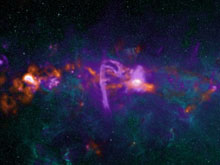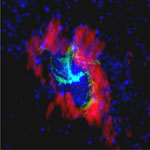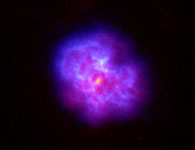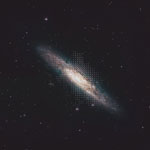
First Prize: The Galactic Center

Second Prize: The Heart of Draco: the Radio Galaxy 3C 305

Third Prize: The Supernova
of 386 AD
2008 AUI/NRAO Image Contest Prize Winners
Associated Universities, Inc. and the National Radio Astronomy Observatory are pleased to announce and congratulate the prize recipients of the 2008 AUI/NRAO Image Contest.
The power of multiwavelength imaging is the common theme of winners in the 2008 AUI/NRAO Image Contest. The three top prize winners and three honorable-mention winners combined, all told, data from NRAO and other radio observatories with submillimeter, optical, infrared, and X-ray data from ground-based and orbiting observatories. Twenty images were submitted by 11 scientists.
The results were both scientifically intriguing and beautiful.
The $1,000 first prize went to Adam Ginsburg of the University of Colorado-Boulder, for a radio-submillimeter-infrared composite of the Milky Way's complex and fascinating central region. The image shows the relationships among hot, massive star formation, supernova remnants, cold molecular gas, and magnetic fields in the region near our Galaxy's central black hole.
The second prize winner, Francesco Massaro of the Harvard-Smithsonian Center for Astrophysics, used radio, optical, and X-ray data to produce a compelling image of the radio galaxy 3C 305 in the constellation Draco.
The third prize image combined radio and X-ray data of the remnant of the Supernova of 386 AD. Mallory Roberts of Eureka Scientific, Inc., and Cindy Tam of McGill University, continued the work begun by the ancient Chinese astronomers who observed the supernova explosion. The X-ray data reveals a wind created by a pulsar at the center of the remnant.
Three images received honorable mentions. Fahad Yusef-Zadeh of Northwestern University won for an image of stars and gas orbiting the massive black hole at the Milky Way's center. Michael Bietenholz of York University and Hartebeesthoek Radio Observatory won for a radio-X-ray image of the pulsar-powered supernova remnant G21.5-0.9, and Volker Heesen of AIRUB won for an image revealing the magnetic-field structure in the nearby starburst galaxy NGC 253.
"Our congratulations go to all the winners, along with our appreciation for their efforts at making beautiful images that provide unique scientific insights," said NRAO Director Fred K.Y. Lo. "We also want to thank the Prize Panel who volunteered their time: Zolt Levay of the Space Telescope Science Institute; and Aeree Chung, Ron Maddalena, and John Stoke of the NRAO."
First Prize ($1,000)

The Galactic Center
The Galactic Center and the surrounding Central Molecular Zone comprise the most active star formation region in the Milky Way. This 2 x 1 degree field was imaged at 20 cm (purple) with the NRAO Very Large Array, tracing H II regions that are illuminated by hot, massive stars, supernova remnants, and synchrotron emission. Emission at 1.1 mm (orange) was observed with the Caltech Submillimeter Observatory and highlights cold (20-30 K) dust associated with molecular gas. Some of this material will form stars within in the next few million years; the remainder will be blown away. The diffuse cyan and colored star images are from the Spitzer Space Observatory's Infrared Array Camera. The cyan is primarily emission from stars, the point sources, and from polycyclic aromatic hydrocarbons (PAHs), the diffuse component.
Investigators: Adam Ginsburg and John Bally (Univ of Colorado - Boulder), Farhad Yusef-Zadeh (Northwestern), Bolocam Galactic Plane Survey team; GLIMPSE II team
Image submitted by: Adam Ginsburg (Univ of Colorado - Boulder)
Second Prize ($500)

The Heart of Draco: the Radio Galaxy 3C 305
Telescopes that allow scientists to study the Universe at radio, optical, and X-ray wavelengths were used to create this intriguing image of the radio galaxy, 3C 305, which is located in the constellation of Draco the Dragon. The radio data (blue) were acquired at a wavelength of 21 cm with the NRAO Very Large Array and with the Multi-Element Radio-Linked Interferometer Network (MERLIN) operated by the Jodrell Bank Observatory. The images at optical and X-ray wavelengths were obtained with the Hubble Space Telescope (cyan) and Chandra X-ray Observatory (red), respectively. Note that the radio emission is not directly connected with that of the X-rays, while the optical emission seems to be associated with the high-energy X-ray emission.
Investigators: Francesco Massaro and Eli Bressert (Harvard-Smithsonian Center for Astrophysics); Annalisa Bonafede and Elisabetta Liuzzo (INAF Instituto di Radioastronomia)
Image submitted by: Francesco Massaro (Harvard-Smithsonian Center for Astrophysics)
Third Prize ($250)

The Supernova of 386 AD
This composite radio and X-ray image shows G11.2-0.3, the remnant of a supernova observed by Chinese astrologers in 386 A.D. as a "guest star" in the Nan-tou Asterism. The radio data were obtained by scientists studying this supernova remnant with the NRAO Very Large Array at wavelengths of 20 cm (red) and 3.6 cm (green). The bubble in the remnant¹s center is greener than the outer shell because a central nebula is being created by a powerful wind coming off the pulsar at almost the precise center of the shell. This pulsar spins 15 times per second and the energetic electrons created by the wind can be seen in the Chandra X-ray Observatory image (blue). This astronomical object is a textbook example of a Type II supernova remnant created by the collapse of a massive star's core into a neutron star. G11.2-0.3 is sometimes called "The Turtle" because of its nearly perfect shell and because the pulsar is moving unusually slow.
Investigators: Mallory Roberts (Eureka Scientific, Inc.) and Cindy Tam (McGill University)
Image submitted by: Mallory Roberts (Eureka Scientific, Inc.)
Honorable Mentions ($100)

Stars and Gas Orbiting the Massive
Black Hole Sgr A*
Our Milky Way, like many other galaxies, harbors a massive black hole at its center that greatly influences the evolution of the nearby stars and gas. This image of the Milky Way's central region combines data over a wide range of wavelengths and include radio images from the NRAO Very Large Array (green) and BIMA (red) as well as an infrared image from the NASA Spitzer Space Telescope (blue). The red, green and blue colors represent, respectively, the cold gas, warm gas, and stars that are orbiting the Milky Way's supermassive black hole, SgrA*. Note the three-armed appearance of the ionized gas in the radio image that is superimposed on the distribution of the much colder molecular HCN emission.
Investigators: F. Yusef-Zadeh (Northwestern University), M. C. H. Wright (UC Berkeley) and S. Stolovy (Spitzer Science Center)
Image submitted by: F. Yusef-Zadeh (Northwestern University)

A Radio and X-ray image of G21.5-0.9
A radio X ray composite image of the pulsar-powered supernova remnant, G21.5-0.9, includes data from the NRAO Very Large Array (blue) and the Chandra X-ray Observatory (red). The remnant is what remains of a supernova that exploded in our Galaxy about 1000 years ago. The core of the original star has collapsed to an incredibly dense neutron star or pulsar, which spins rapidly and emits an energetic wind of particles and magnetic field that energizes the filamentary nebula visible in the radio and in the X-ray. Although the pulsar is not seen directly, we can infer that the pulsar is located inside the bright X-ray region that is seen here as the central orange spot.
Investigators: M. Bietenholz (Hartebeesthoek Radio Observatory and York University), N. Bartel (York University); H. Matheson and S. Safi-Harb (University of Manitoba); NASA/CXC
Image submitted by: Michael Bietenholz (York University)

The Magnetic Field Structure in the Nearby Starburst Galaxy NGC 253
Our best information about magnetic fields in other galaxies is obtained by studying the radio-wavelength synchrotron radiation emitted by cosmic-ray electrons as they move through a galaxy's magnetic field. In this image, radio data from the NRAO Very Large Array and the 100-m Effelsberg telescope are combined with a three-filter, optical wavelength image of the nearby galaxy NGC 253 (the "Silver Coin" galaxy) from the ESO Wide Field Imager. The vectors overlaid on the optical image show the orientation of the magnetic field in NGC 253, as measured by the radio data; the vector length is proportional to the polarized emission. Note that the magnetic field is detected not only in the galaxy's disk but also above and below, demonstrating the presence of a "radio halo." This may be caused by an outflow of gas from the disk into the halo.
Investigators: Volker Heesen (AIRUB), Rainer Beck (MPIfR), Marita Krause (MPIfR), and Ralf-Jürgen Dettmar (AIRUB)
Image submitted by: Volker Heesen (AIRUB)
